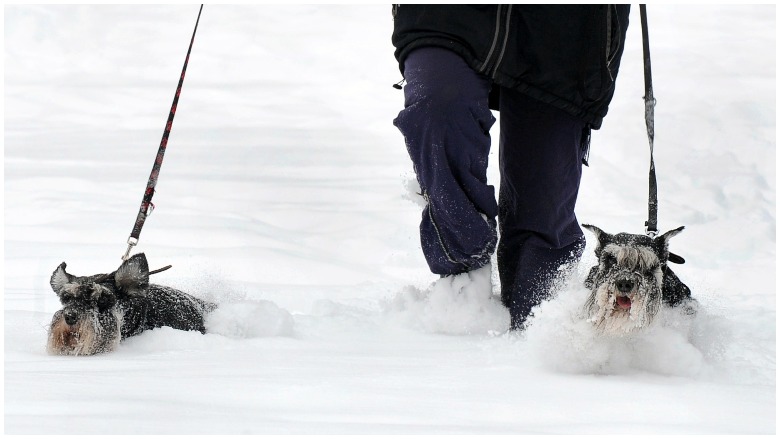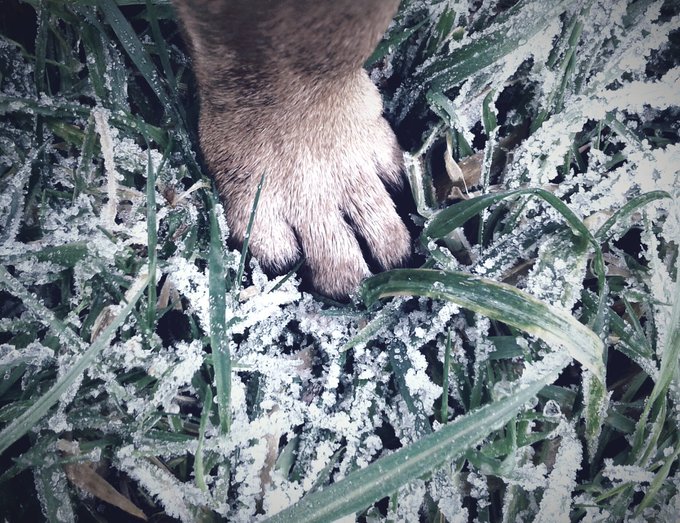
Getty Frostbite and hypothermia can set in as quickly as five minutes during blasts of arctic weather like the Midwest is experiencing right now. Here's what to look for.
Frostbite and hypothermia can set in as quickly as five minutes during blasts of arctic weather like the Midwest is experiencing right now. With areas of Wisconsin, Michigan and Illinois reaching temperatures of -50 degree Fahrenheit through Wednesday and Thursday, each state is warning citizens to take extra precautions when venturing outside, imploring people to limit exposed skin and wear as many layers as possible if forced to leave the house.
With frigid winds already blowing through the Midwest and expected to drop even further, many families are left wondering how they can protect their pets as well as themselves during such arctic, record-breaking cold snaps.
You can check out a full list of tips and advice on how to keep your furbabies safe here, and continue reading for information on how to protect your pet from hypothermia and frostbite.
Signs of Hypothermia in Pets
According to PetMD, a dog’s normal body temperature is between 101°F and 102.5°F, so anything below 100°F is considered hypothermia in dogs. Cats normally maintain a body temperature between 100.5 and 102.5 degrees Fahrenheit, so anything falling below these levels also puts your cat at risk.
Pets that are exposed to severe cold weather for lengthy periods of time (or, in some cases, very little time with temperatures such as they in the Midwest), if they fall in a large body of cold water, or are wet and cold for too long, they have a higher risk of catching hypothermia. Shock can also induce hypothermia, as well as certain types of diseases (such as kidney disease) and while your pet is under anesthesia.
Signs of hypothermia in pets include the following:
- Violent shivering, followed by listlessness
- Problems breathing
- Weak pulse
- Lethargy
- Muscle stiffness
- Lack of appetite
- Paleness of the skin
What To Do If You Suspect Hypothermia
If sustained, hypothermia in dogs and cats may lead to several complications and can quickly become fatal. If you suspect your pet has hypothermia, immediate veterinary care is crucial. However, if you are unable to seek medical attention, there are a few things you can do to help warm them back up, courtesy of PetMD:
- Warm some blankets in the clothes dryer or with a hair dryer, and then wrap your pet.
- Wrap a hot water bottle in a towel and place it against your pet’s abdomen. Do not use it unwrapped, as this will burn the skin. A heating pad will also work on the lowest setting, wrapped in a towel. (PetMD recommends that you never place your pet on top of the heating pad or leave a heating pad turned on for more than 10 minutes at a time, and to continue checking the temperature of their skin while the heating pad is in use.)
- Check their temperature every 10 minutes. If it is below 98°F (36.7°C) and not rising, seek immediate veterinary attention.
- Once the temperature is above 100°F ( 37.8°C), you can remove the hot water bottle to avoid overheating. Keep your pet in a temperature-controlled room.
- Continue monitoring their temperature every 15-30 minutes until he is awake, walking around and behaving normally.
Signs of Frostbite in Pets
Dogs and cats with thick fur are just as susceptible to frostbite as pets with shorter coats, and require the same type of caution to prevent frostbit paws, ears and tails. Frostbite on dogs is not usually a life-threatening condition in and of itself, but it does often proceed hypothermia in dogs, which can be fatal, according to PetMD.
Signs of frostbite on dogs and cats include the following, courtesy of ABC Chicago:
- Tips of ears and tail have red- or gray-tinged skin
- Skin often appears pale, grayish-white or blue at first, and red/puffy later
- Pain in ears, tail, or paws when touched
- Skin that stays cold and brittle or appears shriveled
- For cats: paws, tail, and ears are most vulnerable
- For dogs: tail, ears, foot pads, and genitals are most vulnerable
- Ice may occasionally form on the area
“When the body part is warmed and blood flow returns, the skin becomes red and there is swelling accompanied by peeling,” PetMD reports. “This is very painful and may lead to blisters or skin ulcers. As dog frostbite progresses, the area becomes blackened, which indicates death of the local tissue.”
What To Do If You Suspect Frostbite
Frostbite occurs in similar ways that hypothermia does, although frostbite is not as life-threatening initially. Prolonged exposure to cold weather, especially cold, wet weather, causes the blood vessels to constrict, cutting off blood flow to the affected area. As exposure to the cold continues, your pet’s body will eventually cut off blood flow to the most extreme edges of the body entirely, to protect their most vital organs.
If you suspect your pet has frostbite, take the following steps to prevent loss of extremities, necrotic tissue decay and hypothermia:
- Warm a towel in a clothes dryer, or using a handheld hair dryer. Do not directly warm the dog with the hair dryer or other heat source, PetMD warns.
- Apply the warm towel to the affected areas, but avoid squeezing or rubbing too hard, as this can cause more damage. Keep the area warm.
- Use tepid water to warm up the affected areas to a temperature of 100°F (32°C), but no higher than 108°F, as this can cause more damage, according to PetMD.
It is always recommended to seek veterinary attention to make sure no further damage has been done. Keep an eye on the affected area – as the extremity begins to thaw, it will redden, but if it becomes a dark, deep red instead, seek immediate medical attention for your pet.
Prevention Tips
Hypothermia and frostbite in pets can be prevented by avoiding prolonged exposure to cold weather and snow. If you have an outdoor dog or cat, bring him/her inside when temperatures are below freezing. This is essential – just because certain types of dogs seem to like cold, snowy weather does not mean that they aren’t susceptible to frostbite and hypothermia.
Also keep a close eye on your pet when you let them outside during cold snaps, as snow and frost can be disorienting for a pet and they can easily lose their scent and get lost. Provide booties when possible, to avoid frostbite on the paws, and make sure to clean paws, tails and ears with a warm washcloth when they come back into the house, to rinse out de-icing salt (which is dangerous to pets) and warm them back up.
READ NEXT: How to Keep Pets & Animals Safe During Dangerous Cold Snap

